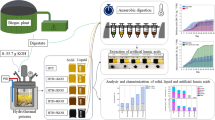The paper considers technologies for obtaining sorption materials from agricultural processing waste. It is shown that after the separation of valuable components from microalgae and duckweed a large amount of residual biomass is formed, which is a waste. This waste contains cellulose (23.5%), starch, hemicellulose, chitin-and pectin-like substances that cause the sorption properties of biomass. A microstructural analysis of the residual biomass showed a loose surface composed of the tissues of destroyed cells, which proves the high sorption capacity of the residual biomass. The possibility of using residual biomass for wastewater treatment to remove heavy metal ions has been studied and it has been shown that the maximum efficiency of treatment is achieved by residual biomass after heat treatment at 400°C. A unit for obtaining adsorption materials from residual biomass has been developed and created. Economic calculations of the developed installation were made, the payback period is 6 months, and the profit from using this setup is estimated to be $7899 per year.





Similar content being viewed by others
References
L. A. Zemnukhova, E. D. Shkorina, and I. A. Filippova, “Study of the sorption properties of rice husks and buckwheat in relation to oil products”, Khimiya Rastitel’nogo Syr’ya, No. 2, 51–54 (2005).
Pat. RF 205111672/15 (013536), Method of Obtaining Sorbent [in Russian], L. А. Zemnukhova, E. D. Shkorina, and I. A. Filippov (2006).
N. S. Chikina, A. V. Mukhamedshin, and L. A. Zenitova, “The use of a sorbent based on polyurethane foam and buckwheat husks in the elimination of hydrocarbon spills”, Bezopasnost’ Zhiznedeyatel’nosti, No. 9, 21–24 (2008).
M. B. Shchepakin, I. G. Gafarov, G. M. Mishulin, and I. Kh. Israfilov, “Ecological and technological complex for purification of the hydrosphere to remove oil and oil products”, Ekologiya i Promyshlennost’, November, p. 40–44 (2000).
N. A. Sobgaida and L. N. Olshanskaya, Resource-Saving Technologies for the Use of Sorbents for the Purification of Wastewater from Oil Products [in Russian], Nauka, Saratov (2010).
N. A. Sobgaida, L. N. Ol’shanskaya, and Yu. A. Makarova, “The effect of modifying wheat husk on its sorption properties for Pb2+, Cd2+, Zn2+ and Cu2+ ions”, Izvestiya Vysshykh Uchebnykh Zavedenij. Ser. Khimiya i Khimicheskaya Tekhnologiya, 53, No. 11, 36–40 (2010).
N. A. Sobgaida, L. N. Ol’shanskaya, and Yu. A. Makarova, “Wastewater treatment to remove heavy metal ions using sorbents — woodworking and agricultural industrial waste”, Khim. Neftegaz. Mashinostr., No. 9, 43–45 (2009).
N. A. Sobgaida, L. N. Ol’shanskaya, K. N. Kutukova, and Yu. A. Makarova, “The use of industrial waste as sorbents of petroleum products”, Ekologiya i Promyshlennost’ Rossii, January, 36–38 (2009).
E. A. Taranovskaya, N. A. Sobgaida, D. V. Markina, “Technology for obtaining and using granulated absorbents based on chitosan”, Chem. Petrol. Eng., 52, I. 5–6, 357–361 (2016).
N. A. Sobgaida and Yu. A. Makarova, “Influence of the nature of the binder on the sorption properties of sorbents made from agricultural waste”, Vestnik Saratovskogo Gosud. Tekhnicheskogo Universiteta, No. 1, 41–45 (2011).
N. Kobayashi, E. A. Noel, A. Barnes, et al., “Characterization of three Chlorella sorokiniana strains in anaerobic digested effluent from cattle manure,” Bioresource Technology, 150, 377–386 (2013).
H. G. Gerken, B. Donohoe, and E. P. Knoshaug, “Enzymatic cell wall degradation of Chlorella vulgaris and other microalgae for biofuels production,” Planta, 237, I. 1, 239–253 (2013).
Author information
Authors and Affiliations
Corresponding author
Additional information
Translated from Khimicheskoe i Neftegazovoe Mashinostroenie, Vol. 56, No. 7, pp. 18–20, July, 2020.
Rights and permissions
About this article
Cite this article
Politaeva, N.A., Smyatskaya, Y.A. & Efremova, S.Y. Production of Sorbents from Residual Biomass of Chlorella Sorokiniana Microalgae and Lemna Minor Duckweed. Chem Petrol Eng 56, 543–547 (2020). https://doi.org/10.1007/s10556-020-00807-7
Published:
Issue Date:
DOI: https://doi.org/10.1007/s10556-020-00807-7




